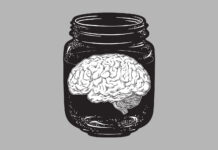The “seductive allure of neuroscience explanations” (SANE) refers to the phenomenon, observed in past research findings, that people show greater trust in studies with neuroscience language, graphs, and especially brain images.
Now, a study by Soo-hyun Im and colleagues at the University of Minnesota demonstrates that this effect applies to educational research as well. The article, published in the British Journal of Educational Psychology, showed that participants rate explanations of education research as more “credible” if they include images of the brain with large structures highlighted.

The current study included 245 laypeople, recruited through Amazon’s Mechanical Turk. They were tasked with reading brief articles about educational psychology. There were four types of articles: 1) those that included no neuroscientific information; 2) those that included a verbal neuroscientific explanation; 3) those that included both the verbal explanation and a graph; and 4) those that included the verbal explanation as well as brain images. The participants were then tasked with rating credibility of these articles.
According to the researchers, the participants tended to rate the articles as most credible when they included both verbal descriptions of neuroscience and brain images. The verbal description alone did not make a significant effect, nor did the inclusion of the graphs. It seems the addition of brain imagery was what accounted for the jump in perceived credibility.
This effect was not limited to people with no knowledge of psychology or neuroscience. According to the researchers, the result “persisted even after controlling for individual differences in familiarity with education, attitude towards psychology, and knowledge of neuroscience.” In fact, the effect appeared to be greater when participants had some knowledge of the subject matter and neuroscience.
Previous research corroborates this surprising finding, finding that psychology students are particularly susceptible to this effect. Researchers theorize that psychologists prefer neuroscience explanations for human behavior because they consider them to be more in-depth, more causal explanations. However, this mindset appears to cause them to be more easily misled by the addition of irrelevant neuroscience.
Previous researchers have suggested that brain images provide a reductionistic explanation that makes it easier for the public to make sense of a complex experience (such as education). However, the popular press often misuses (or misunderstands) neuroscience—which can lead both laypeople and professionals to develop beliefs in neuroscience myths—such as the chemical imbalance theory of mental illness.
It should be noted that other studies have altered the methods of these experiments, and found that this effect only occurs in certain conditions. That is, when it is apparent that the neuroscience context is irrelevant, people appear somewhat less susceptible to being misled. However, in most cases, neuroscientific explanations are presented as if they are relevant to the findings.
Another limitation of the present study is that the addition of neuroscientific explanations and brain images increased the length of the article. Thus, longer, more image-rich articles might be perceived as more credible. However, if this study suggests that padding article length and including irrelevant images increases perceived credibility, that is also a significant finding.
Finally, a limitation of this study is that the extra neuroscientific content could be viewed as relevant—in that it is framed as “corroborating” the psychological finding. However, the researchers did not find the effect on credibility when only the verbal neuroscientific explanation was added. Only when the brain image was added did the result appear. That is, the addition of a brain image makes a study seem more credible, while the actual explanation of the neuroscience does not.
The authors write that there have been many approaches to education policy that have been justified by questionable neuroscience, and which have turned out to be unsupported by further evidence. In this context, they suggest that policymakers be more careful before assuming that brain images make a study more credible.
****
Im, S., Varma, K., & Varma, S. (2017). Extending the seductive allure of neuroscience explanations effect to popular articles about educational topics. British Journal of Educational Psychology, 87(4), 518-534. https://doi.org/10.1111/bjep.12162 (Link)















What can I say but, Baaaaaaah?
Report comment
Several years ago this was also true of Science magazine. Brain studies needed scans to get published. I believe this on longer the case.
Report comment
The average person is easily deceived by the perception of “sciency-ness.” We have a tendency to want to believe that some smart, “scientific” person is going to figure things out and explain them to us, and if we agree, we’ll feel smart, too. I am afraid our educational system helps make us this way. “Science” in school is not about experiment and discovery, it’s about getting the “right” answer as “discovered” by some other person smarter than we are. Not sure what is necessary to change that, but science teaching most definitely has to change.
Report comment
“Sciency-ness” is my new favorite word ever.
Report comment
I agree.
Report comment
Maybe Richard L will prefer it over “scientism.”
Report comment
I’m pretty certain they refer to the same thing, BS science.
Report comment
Thanks! I’ve always wanted to invent a word that achieves general acceptance in the language. Maybe this is my big hit!
Report comment
This likely explains the allure for some of Daniel Amen, PBS’s in-house bio-shrink.
Report comment
He is very “sciency.” Pretty brain pictures mean he must be smart and know more than you and me. The new breed of charlatan.
Report comment
Dr. Oz has some “sciency” shticks. Mostly not related to psychiatry. Perhaps the medical premises are sound, but his demonstrations are not.
He’ll fill telephone booths with balloons and have guests get in to pop them and other bizarre “visuals” that have little if any bearing on the medical point he’s trying to make. But the audience eats it up.
Baaaaaah!
Report comment
More accurate visuals for psychiatry might include a hammer and nails on a human brain, a jackhammer, or simply a boot stomping on a human brain. Such images would be closer to “science” than any of these silly scientistic brain scans.
Maybe someone can draw this up: a brain scan that reveals an empty skull of a person performing a brain scan.
Report comment
Good idea, Dragon Slayer. Share it with Auntie Psychiatry. 🙂
Report comment
It seems to me that people have a need for faith/trust in something greater than themselves which will look out for and take care of them. It makes sense that since science to some degree dethroned religion’s fulfillment of this function for many people, that science would then assume this role. That could explain why it doesn’t take much to dupe millions of people into believing and holding steadfastly to the illogical/ridiculous ideas put forth by psychiatry and big pharma (or any other sciency-sounding scams that ride their coat-tails).
Report comment
I agree, but I also believe that it is the accepted paradigm; it is promoted by cultural leaders and many others besides psychiatrists and Big Pharma. Moreover, I believe that the general public has no idea about the BS that currently passes for science.
Report comment
The largely unconscious desire among “progressives” to find something “rational” to substitute for religious dogma is a motivation that probably explains much of their reluctance to look at psychiatry objectively. I have made note of this for some time.
Report comment
Oldhead, how do you account for conservative churches who are embracing the “science” of psychiatry more and more? They still don’t believe in evolution and other stuff that scientists teach.
Yet despite their lip service to the concept of human souls they don’t believe in them it seems. Or maybe normals (like them) have souls but the “mentally ill” do not.
Report comment
Leukoaraiosis – white matter hyperintensities show up good and proper on brain scans of people subject to neurotoxic psychiatric drugs :
Reference: Grace E Jackson
https://youtu.be/x9UL-y0DnJg?t=2163
Report comment
In other words: vascular dementia.
Report comment
“Although commentators bravely assert that ‘advances in neurobiological research methods allow one to address the nature and biological basis of human behavior’ [and] that jurors can be counted on to critically evaluate such evidence…. the visual allure [of neuroimaging evidence] dazzle and seduce jurors in ways that are “inappropriately persuasive.” Perlin, Michael & Rae McClain, Valerie. (2010). Unasked (and Unanswered) Questions About the Role of Neuroimaging in the Criminal Trial Process. American Journal of Forensic Psychology. 28.
Report comment
Hmm.
A certain part of a brain scan lights up when a person is unhappy. Ergo, everything psychiatrists say about depression and other stuff must be right.
I’m not sure what fallacy of thought this is. I’m pretty sure there is one related to this line of unreasoning. Need to look it up.
Report comment